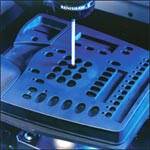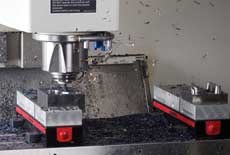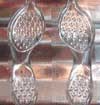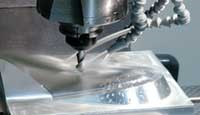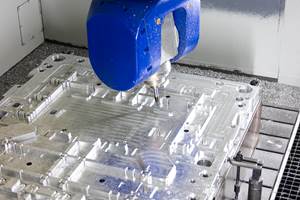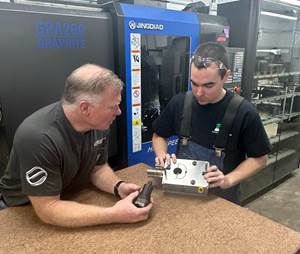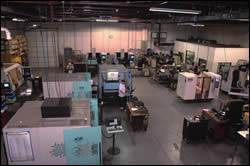Selecting an Economical VMC for Mold Machining
The key to investing in the right vertical machining center is in sizing up your current process requirements and machining capabilities, while factoring in future work.
Cutting speed and surface finish are frequently the topic of discussion on shop floors of hundreds of mold shops. There’s a relentless quest for reducing machining time per mold, achieved by faster feedrates and traverse rates. Of equal concern is assur-
ance that optimum surface finishes are being produced by the machining process with little or no hand finishing on the bench.
The trick is to procure the right level of machining center technology with available capital expenditure funds, which are often limited by the nature of the business and market pressures.
The question “What is it that we really need?” is going to be answered differently depending on the type of molds produced, the materials machined and the number of machines available. However, when it comes to vertical machining centers (VMCs), there are certain factors where the best “bang for the buck” waivers very little no matter what shop you’re in.
Fast Feedrates
The more mold cavity work you do, the more the potential cycle time savings from faster feedrates. The good news is this: moldmakers can double or even triple machining feedrates to gain faster cycle times with a new VMC under $50,000. New productivity-enhancing technology is readily available in that price range, despite the fact that many machining centers can run into the hundreds of thousands of dollars.
Figuring the right blend of spindle power, torque and speed is the equation to be solved, and you don’t necessarily need the maximum spindle speed capabilities to gain the ideal feedrates. Optimizing your metal removal rate—whether it be for roughing or finish operations—is a function of both spindle speed and the machine control’s ability to stay ahead of the data-flow needs of the machining program. A high spindle speed alone is not enough.
In a typical steel mold finishing application, you’re probably often cutting at a rate between 800 to 1200 surface feet per minute (SFPM), with an end mill that is 3/8" diameter. 10,000 rpms is all you need; 15,000 rpm maximum. Spindle cost goes up dramatically above this level with only small incremental gains in productivity.
For very fine detail operations with a very small OD tool, 20,000-rpm spindles and higher can be worthwhile, but they are overkill otherwise. In most situations, the balance between torque and spindle speed is determined by the material being machined and the amount of it to be removed in a rough cut. The 10,000 to 15,000 rpm range is suitable for 70 to 80 percent of mold manufacturing jobs.
The more complex the toolpath and the higher the feedrates, the more need for fast processing speeds from the control. If the distance that the tool has to move during a given program event takes less time than it takes to process the block of commands, your machine hits the data-flow limit and data starvation impedes machining efficiency.
The look ahead feature available on newer controls allows the machinist to optimize cutting speed—ensuring intelligent acceleration and deceleration of the feedrate along the toolpath. It determines how to schedule the feeding of program data to keep the tool running smoothly, planning for any sharp moves that have to be made.
Unless your machine is using a very high-speed spindle at over 900 ipm, you don’t need a look ahead buffer that’s more than 500 to 1,000 blocks since today’s processor speeds are quite good. Depending on your programming process, control software packages designed specifically for moldmaking, also are helpful.
Note: In the majority of applications, integral motorized spindles are not needed to deliver higher spindle speeds. Given that they can be five times the cost of a geared or belt-driven spindle, integral motorized spindles are a luxury.
Rigidity and Accuracy
Machine rigidity minimizes vibration at the tip of the cutter, allowing you to achieve a fine surface finish. You can’t afford to skimp here; the machining center architecture must be capable of effectively absorbing vibration. The base and column should be engineered with heavily ribbed cast iron construction.
The key advantage of a box way system is vibration dampening. When you make a heavy cut, the machine experiences vibration as a result of the significant forces developed. The large contact area between the box ways and the table—combined with overall rigidity of the machine—will significantly reduce vibration by increasing dynamic stiffness.
As a machine tool heats up, thermal growth becomes the enemy of accuracy and threatens your confidence in holding tight part tolerances. When the machine is designed with symmetrical structures, it helps, because when heat-related growth occurs the tool center point does not move and tolerances are not affected.
Higher speed spindles require air/oil lubrication that coats the spindle bearings and reduces friction, so the spindle runs cooler (and lasts longer). Ceramic bearings in steel races also help—they have a heat expansion rate of about one-third that of steel, which prevents heat build-up at higher speeds. This type of spindle also maintains bearing preload better.
A closed-loop, self-monitoring refrigeration system for the spindle is the best way to ensure consistent positioning accuracy. The spindle cartridge and machine headstock are cooled by recirculating refrigerant.
Ball screws are the other problematic heat generating source. Friction can be reduced by separating the balls as they flow through the nut, so that they don’t rub against each other, thus reducing friction.
One way to maintain precision despite thermal changes is to use glass scales on the way units, giving you the closed-loop feedback to ensure “You got there” and that positioning repeatability is consistent. This enables you to cold start the machine and produce quality parts right away, but it adds significantly to the cost of the machine.
Strategies where the machine builder or user tries to predict how the machine will deflect when it is hot, and then devises predetermined compensation, do not work very well for this class of vertical machining centers.
Extra Axes
Selecting a vertical machining center with extra workpiece orientation capability (i.e. integral 5-axis machining) is typically only cost-effective if the mold components are very complex in terms of geometry. Consider using a fourth or fifth axis add-on unit on the table. This can mean fewer setups to complete a mold component, giving you higher machine utilization.
Maintenance and Support
When you’ve settled on all the machine specs that match your needs, and you’re ready to buy the machine and make its capabilities part of your customer-winning playbook, there’s one more factor to consider before you pull the trigger on the purchase order: machine maintenance and support.
Ask other metalworking colleagues about reliability related to a given machine or brand. And look at the depth of the service support, spare parts availability, and retrofit or upgrade options. Is the machine tool manufacturer poised to help you minimize the total cost of ownership over the long run?
Summary
Sizing up your current process requirements and your current machining capabilities, while factoring in future work you can predict or will seek, is the key to investing in the right VMC.
References
- MAG Fadal 3016FX with Fadal GE Fanuc 0i-MC Control with “look ahead” capability.
- MAG Fadal VMC 6535.
- MAG Fadal VMC 4020.
- MAG Fadal VMC 4525.
Related Content
True Five-Axis Machine Yields More Throughput, Greater Productivity
CDM Tool & Mfg. Co. LLC increased shop capacity thanks to a versatile high-speed/high-accuracy five-axis Fooke mill capable of cutting very large workpieces quickly and accurately with fewer setups.
Read MoreFive-Axis Graphite Mill With Automation Debottlenecks Electrode Machining
Five-axis electrode cutting enabled Preferred Tool to EDM complex internal screw geometry on an insert that otherwise would have had to be outsourced.
Read MoreSpeed, Productivity Gains and High Uptime Ease Decision for Second Five-Axis Machine
Byrne Tool + Design reduced setups and gained speed and productivity thanks to fast, accurate and compact five-axis CNC machining centers.
Read MoreRead Next
How to Select and Use Your Vertical Machining Center
Competitive shops need to consider the true capabilities of their VMCs to achieve a high level of accuracy and surface finish.
Read MoreFaster Response with Reduced Contour Machining Cycle Time
Contract injection mold producer optimizes VMC capability to retain competitive advantage.
Read MoreHow to Use Continuing Education to Remain Competitive in Moldmaking
Continued training helps moldmakers make tooling decisions and properly use the latest cutting tool to efficiently machine high-quality molds.
Read More
